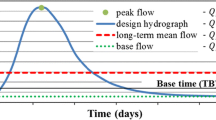Abstract
Hydrological frequency analysis is the foundation for hydraulic engineering design and water resources management. However, the existence of uncertainty in sample representation usually causes the uncertainty in quantile or design value estimation. Standard deviation (SD) of the design value with a given non-exceedance probability, as an extremely valuable indicator, is suggested to quantify the uncertainties of hydrological frequency analysis. In order to assess the impact of the sampling uncertainty on design value, in China’s national standard for design flood calculation, an empirical formula for estimating SD of the design value was suggested; however, it is applicable only to the case that Pearson type three probability distribution function (PE3) and method of moment are used to analyze the hydrological samples. In principle, for other types of probability distribution functions and parameter estimation methods, the suggested empirical formula is not suitable. The aim of this article is to propose a general approach to estimate the SD of a design value by using the Bootstrap resampling technique. In order to testify the applicability of the approach, under the condition of PE3 distribution, three kinds of schemes were designed to calculate SD, i.e. the suggested empirical formula in China’s national standard for design flood calculation (SEF), Bootstrap technique with method of moment for parameter estimation and Bootstrap with linear moment for parameter estimation. The annual precipitation observations from 50 gauges around China were analyzed using these three approaches. Results show that the SD values of quantile estimates are significantly different among these three approaches, which means that when parameter estimation methods rather than method of moment are employed, the SD provided by SEF is inapplicable. It also indicates that, in terms of modified design value, i.e., original design value adding security correction value, the proposed method using the Bootstrap method, as a general method for SD estimation, is effective and feasible.




Similar content being viewed by others

References
Changjiang Water Resources Commission (CWRC), Nanjing Institute of Hydrology and Water Resources (1995) Handbook for calculating design flood of water resources and hydropower projects. China Water Power Press, Beijing, pp 34–86
Ding J, Yang R (1988) The determination of probability weighted moments with the incorporation of extraordinary values into sample data and their application to estimating parameters for the pearson type three distribution. J Hydrol 101(1):63–81
Efron B (1979a) Bootstrap methods: another look at the Jackknife. Ann Stat 7:1–26
Efron B (1979b) Computers and the theory of statistics: thinking the unthinkable. SIAM Rev 21:460–480
Greenwood JA, Landwehr JM, Matals NC, Wallis JR (1979) Probability weighted moments: definition and relation to parameters of several distributions expressible in inverse form. Water Resour Res 15:1049–1054
Hosking JRM (1990) L-moments: analysis and estimation of distribution using linear combinations of order statistics. J R Stat Soc B 52:105–124
Hu Yiming, Liang Zhongmin, Li Binquan, Yu Zhongbo (2013) Uncertainty assessment of hydrological frequency analysis using Bootstrap method. Math Probl Eng. doi:10.1155/2013/724632
Kendall MG (1975) Rank Correlation Methods, 4th edn. Charles Griffin, London
Kirby W (1974) Algebraic boundedness of sample statistics. Water Resour Res 10:220–222
Kuczera G (1982) Combining site-specific and regional information: an empirical Bayes approach. Water Resour Res 18(2):306–314
Kuczera G (1999) Comprehensive at-site flood frequency analysis using Monte Carlo Bayesian inference. Water Resour Res 35(5):1551–1557
Lee KS, Kim SU (2008) Identification of uncertainty in low flow frequency analysis using Bayesian MCMC method. Hydrol Process 22(12):1949–1964. doi:10.1002/hyp.6778
Mann HB (1945) Non-parametric tests against trend. Econometrica 13:163–171
Nguyen C, Gaume E, Payrastre O (2014) Regional flood frequency analyses involving extraordinary flood events at ungauged sites: further developments and validations. J Hydrol 508:385–396
Overeem Aart, Buishand Adri, Holleman Iwan (2008) Rainfall depth-duration-frequency curves and their uncertainties. J Hydrol 348:124–134
Payrastre O, Gaume E, Andrieu H (2011) Usefulness of historical information for flood frequency analyses: developments based on a case study. Water Resour Res 47:W08511
Reis DS Jr, Stedinger JR (2005) Bayesian MCMC flood frequency analysis with historical information. J Hydrol 313(1–2):97–116
Ribatet M, Sauquet E, Gresillon J-M, Ouarda TBMJ (2007) A regional Bayesian POT model for flood frequency analysis. Stoch Environ Res Risk Assess 21:327–339. doi:10.1007/s00477-006-0068-z
Tang WH (1980) Bayesian frequency analysis. J Hydraul Div 106(7):1203–1218
Tiwari Mukesh K, Chatterjee Chandranath (2010) Development of an accurate and reliable hourly flood forecasting model using wavelet–bootstrap–ANN (WBANN) hybrid approach. J Hydrol 394:458–470
Wallis JR, Matalas NC, Matas NC, Slack JR (1974) Just a moment! Water Resour Res 10:211–219
Wood EF, Rodriguez-Iturbe I (1975a) Bayesian inference and decision making for extreme hydrologic events. Water Resour Res 11(4):533–554
Wood EF, Rodriguez-Iturbe I (1975b) A Bayesian approach to analyzing uncertainty among flood frequency models. Water Resour Res 11(6):839–843
Yeou-koung Tung, Chi-leung Wong (2014) Assessment of design rainfall uncertainty for hydrologic engineering applications in Hong Kong. Stoch Environ Res Risk Assess 28:583–589
Zhongmin Liang, Li Binquan Yu, Zhongbo Wenjun Chang (2011) Application of Bayesian approach to hydrologic frequency analysis. Sci China Technol Sci 54(5):1183–1192
Zhongmin Liang, Wenjun Chang, Binquan Li (2012) Bayesian flood frequency analysis in the light of model and parameter uncertainties. Stoch Environ Res Risk Assess 26:721–730
Acknowledgments
This study was supported by the Major Program of National Natural Science Foundation of China (Grant no. 51190095), the National Natural Science Foundation of China (Grant nos. 51079039, 51309105), and Graduate Research and Innovation Program for Ordinary University of Jiangsu Province (1043-B1305324). We wish to thank the reviewers and editors, whose suggestions have helped us to improve the quality of the paper.
Author information
Authors and Affiliations
Corresponding author
Rights and permissions
About this article
Cite this article
Hu, YM., Liang, ZM., Liu, YW. et al. Uncertainty assessment of estimation of hydrological design values. Stoch Environ Res Risk Assess 29, 501–511 (2015). https://doi.org/10.1007/s00477-014-0979-z
Published:
Issue Date:
DOI: https://doi.org/10.1007/s00477-014-0979-z



